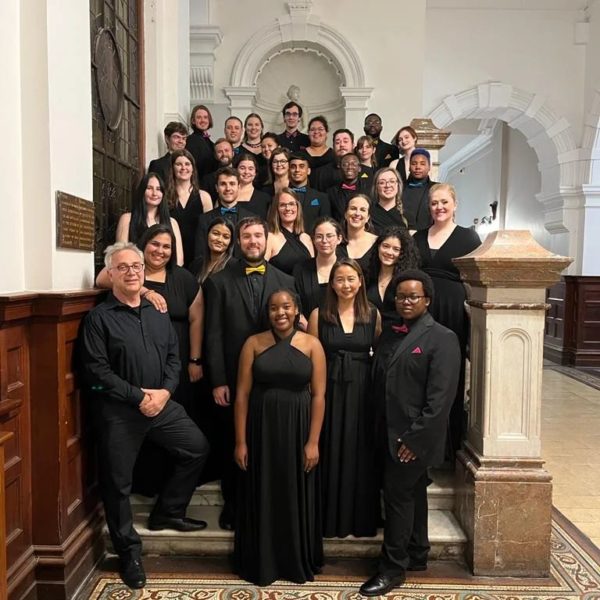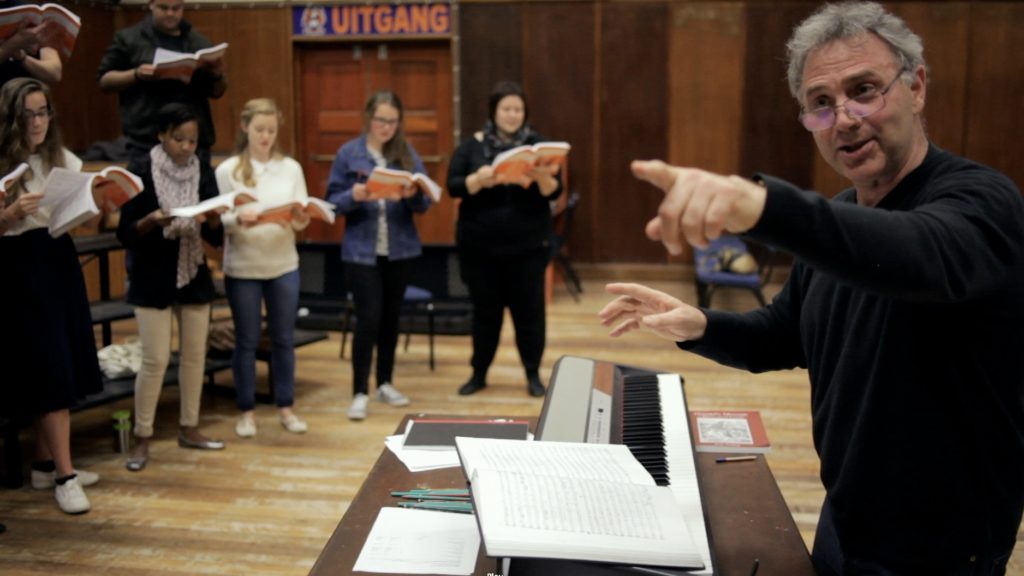Leon Starker, the conductor and leader of the Cape Town Youth Choir, speaks gently and with humility – the way that only someone talented and experienced would.
The Cape Town Youth Choir (CTYC) was formed by André van der Merwe, who Leon explains had an enormous influence on choral music and choral singing in South Africa, country-wide.
“Well, for the white community I should say. I can’t speak for the others. In the sense that he made it his mission to go to competitions and do very well. Because they travelled so much at that point, he introduced a lot of repertoire through these choir tours to local choirs.”
Back then, before the 2010s, choir music and all types of music, were a lot harder to get a hold of. You had to actually travel to all these places to really hear new pieces and get the sheet music.
The choir came as an extension of the Tygerberg children’s choir, which ended after the grade 8 year, and then, left members with no ‘next place’ to go sing.
Also read: Experience a week of art, food and music with Franschhoek Creates
In 2003, Leon took over the choir when André moved on to conduct the Stellenbosch University Choir. The CTYC today has a very distinct sound, which was something he didn’t set out to create, but which happened organically over time.
Leon’s childhood
Leon grew up in Pietermaritzburg and was exposed to the world of choir in high school, where he had a teacher who sparked his love for choir singing. Before she passed away, between his grade 11 and 12 years, she started the choir at his high school, encouraging people to get involved with singing and introducing them to “wonderful music”.
Leon details that although he didn’t take music in high school, he was “utterly in awe” of his choir teacher’s incredible musicianship. In his matric year, he says, the choir was sustained solely because of the momentum she built.
In his final years of high school, Leon sang in the Natal Youth Choir. He then led a music group at Stellenbosch University where he ended up singing in the choir there too. He was studying science and maths at the time.
Following university, Leon started teaching at a school in Bellville, where he went on to become the choir teacher.
The Cape Town Youth Choir
The CTYC is an independent choir, tied to no specific organisation, and with the members coming from entirely different backgrounds. The thing that binds it is purely the love for music and its creation.
As Leon explains, a university choir, for example, has a specific shared rhythm among the members: exam season and location for example. The members function on the same schedule and are bound by something practical. Whereas when a choir has a diverse membership, there is no shared rhythm.
“Everyone goes to the choir because they must love the music, they commit and they work hard because they must be fulfilled from it.”
Choir then vs. choir now
Having a variety of identities within a choir, or a ‘mixed’ choir, is often one of the first things people note when being exposed to a group of singers.
As with everything in South Africa at the time, the choirs Leon participated in and witnessed when he was in school would consist of one race only, limiting the scope of music that was chosen and performed.
“Of course everything was separate, you know, all the white kids had their own systems and their own choirs. There was no interaction, no introduction to the richness of Zulu folk music.”
Once that gap opened up for choirs to start integrating, the progression happened naturally. The music that mixed choirs were producing was new and dynamic. A little later, South Africa became more immersed in what the whole world was doing when the internet grew in popularity.
The internet has been a factor that has drastically changed the culture of choir music and participation in South Africa, Leon explains. Access to music when he was younger was very limited.
“To get hold of music in the 1980s and 70s was just impossible. You’d have to order it from overseas and then someone had to mail it to you. And then you’d only see the music once you had it.”
Also read: The Cape’s favourite Afrikaans outdoor music festival Piekniek en Musiek returns
The accessibility of music has also changed the scope of music that choirs are able to sing, and how quickly they can learn new styles and forms.
“When you look back now, the kind of music that school choirs were singing then would be considered far too easy today. The whole choir world has grown. Things that we sang in university choir are average stuff in today’s world.”
Although youth choirs have no limitations on who can be a member anymore, and mixed choirs are more common, they are still not the norm.
“In the 1980s and 70s, the separation was purely based on colour. Now the separation is less and less but still, youth choirs don’t really mix. And things are changing, but the reason for the separation currently is economics. It’s very expensive to travel to a rehearsal and back.”
“The areas where people live is a result very much of the apartheid legacy. But fixing it is not a ‘changing the law’ thing.”
It is evident that Leon did not specifically intend to have a ‘mixed’ choir. It happened naturally. It feels obvious that there is a wonderful range of music that can be produced by a group with a wide range of people and voices.
“You’ve got this country with all these different, not just musical traditions, but colour sounds. So you get this fantastic mix of sound to produce something unique.”
The Cape Town Youth Choir reflects a very South African style of music and performance, and showcases liberty that you don’t often find in the reserved European tradition. There is not a big physical expression of joy in a cathedral-like setting.
Having toured Europe performing with the choir Leon says, “I think when Europeans see South African choirs let go of their inhibitions, it sort of touches a nerve and it resonates with something they actually want.”
Performance is a huge part of being a musician. As Leon says, “music is about sharing and invoking emotions.” The experience of making music, presenting it, or receiving the performance is a full experience, both mental and physical.
“It’s not just the sound that invokes the emotions, because then you could just put a CD on. But in a performance, the visuals and the body language participate in invoking emotions, and in inviting people to join in on the emotion you’re creating.”
The choir practices Leon holds are ones of collaboration and thoughtfulness. Leon begins the Tuesday and Friday night rehearsals with stretching, breathing and general mindfulness. He does so neutrally, and addresses the secular choir from a mental well-being point of view, rather than a spiritual one.
One may be surprised then, to hear that Leon describes himself as a very religious person.
“For me, this is an expression of that. But I’m also cognisant of the fact that it’s not a religious choir, and that most of the choir members are not. But, I operate from that point.”
The space Leon creates within the choir is non-judgmental, a characteristic of an environment that he believes is really important to have when making music.
“I’m very aware of my own shortcomings as a musician,” he says about being open to suggestions and critiques from the members. “I know I can’t do it without the choir members.”

When mentioning the word ‘multi-cultural’ in describing the choir, Leon seems surprised to hear that this might be a focal point in the choir’s existence.
“When you use the word ‘multicultural’ without intending to there’s a focus on the difference, whereas for me there’s always been a focus on what binds us.”
And what binds people is the music. The song.
“A fulfilling experience comes from doing something very well. If you work hard enough and create something, do the music well, that’s what makes people stay. That for me is an important thing – that we really try and do the music well. And, that is not a cultural thing. Anybody wants to be involved with something that’s really good.”
Listen to the choir here:
See how you can help support the choir here.
Also read:
WATCH: Stellenbosch University Choir warms hearts on SAA flight
Picture: IMDb






